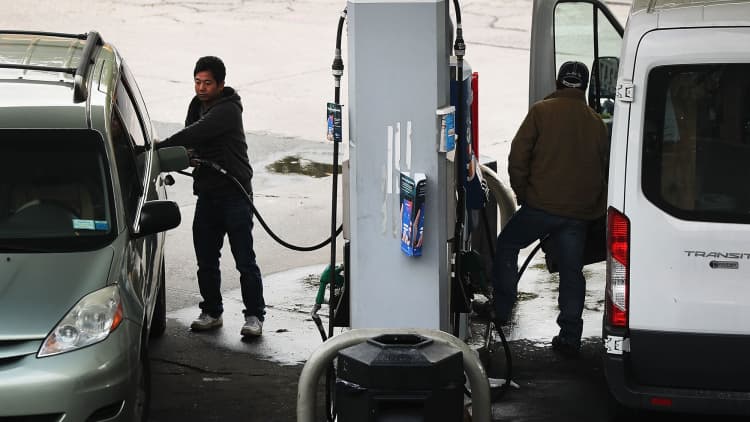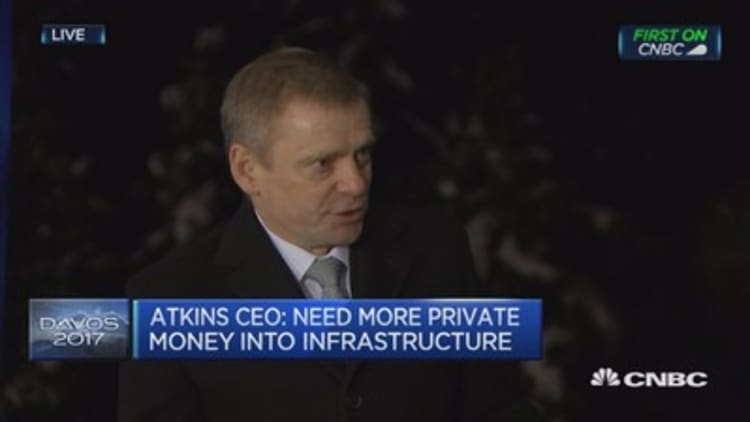
Gasoline purchases can be a powerful signal about the consumer economy, and last month's drop off in demand was downright recession-like.
But economists don't see a recession, and energy analysts say demand picked back up in the last week to a more normal level. Now, they are waiting to see if that continues, and to see if a massive gasoline glut begins to disappear.
In a report Wednesday, Goldman Sachs analysts said while they don't believe there is a recession, they noted that the implied drop of 460,000 barrels a day in January, or 5.2 percent year over year, is the kind of tumble seen only during a recession.
"…such a decline has only occurred in four periods since 1960, during which time PCE contracted," the analysts wrote. They note that government data on consumption — personal consumption expenditures, or PCE — dropped sharply at the same time in those other periods, but it is not lower right now. PCE is expected to grow by 2.6 percent in the first quarter.
"Goldman doesn't think there's a recession, and I don't either," said Tom Kloza, global head of energy analysis at Oil Price Information Services. But Kloza acknowledged there was a mysterious decline in the demand for gasoline decline in January. The government data measures wholesale demand, but Kloza looked at data on drivers' actual purchases at the pump, and they were driving less.
"Our own survey of about 10,000 stations across the country shows that sales gallons were down 4.4 percent in January," he said. "Those are actual sales, and it's a cross section, ranging from big box to mom and pop. I don't disagree with the notion that gasoline demand is going to be much higher in subsequent months, and it will probably be a reasonable driving season."
I think people have an internal thermostat ... They're crazy when it involves gasoline.Tom KlozaOil Price Information Services
But at this time last year, the first week in February was the start of a 33-week run of gasoline demand exceeding 9 million barrels a day. The current four-week average, which analysts watch, stands at 8.3 million barrels a day, according to the Energy Information Administration's weekly report. The EIA showed a pickup on a weekly basis to 8.9 million barrels a day last week, well above the 8.3 million barrels a day of the week earlier.
"Gasoline demand picked up big-time last week. On the question of gasoline demand, I'm not going to get too excited about one week. Demand numbers, in particular, can be erratic and inconsistent week-to-week," said Michael Wittner, global head of energy research at Societe Generale. Wittner also does not see a recession.
The Goldman analysts say their own model for gasoline demand, which looks at growth in PCE, pump prices, efficiency and the number of holidays, shows a much shallower 0.3 percent decline.
There have been a variety of possible explanations given, including winter weather and a surge in consumers upgrading to more fuel-efficient vehicles. Goldman also blamed changes in the Mexican gasoline market, and the fact that the EIA only estimates exports. There was likely lower demand from Mexico, due in part to a 16 percent price hike there. Lower exports would impact U.S. demand numbers, they noted.
Kloza believes the explanation is more simple.
"I think people have an internal thermostat ... They're crazy when it involves gasoline. There were a lot of parts of the country where people were paying $0.40, $0.50 or even $0.70 more in some states than they were in January of 2016," he said. "Crude oil is twice the price we had a year ago."
Crude bottomed at about $26 per barrel last February. West Texas Intermediate futures were at $52.39 per barrel Thursday. According to AAA, the price of gas at the pump Thursday averaged $2.26 per gallon for unleaded nationally. That compares to $1.73 per gallon a year ago.
Gasoline prices averaged $2.33 per gallon last month, compared with just under $1.91 per gallon during January 2016, according to AAA data. Last January also had the strongest demand reading since 2008 based on EIA data, Kloza said.
Data from Oil Price Information Service show the average gas station sold 76,658 gallons in January, compared with 80,199 gallons a year earlier.
Nick Colas, chief market strategist at Convergex, believes the drop in demand could be tied to fuel efficiency. Colas said the Department of Transportation's data on miles driven, available only through November, shows a jump in driving miles. Colas said it suggests that U.S. vehicles are getting an average of about 22 miles per gallon.

The DOT reported that the miles driven on all roads and streets increased 4.3 percent or 10.8 billion vehicle miles in November, over the year earlier. Colas said that was an unusual spike in miles driven.
Car sales were strong last year, and even though many new vehicles were SUVs, many of those are more fuel efficient than older models.
"The upshot…is that implied fuel economy is rising more quickly than at any point since 1973… The relationship between miles driven [DOT] and gas produced [EIA] has been remarkably stable over any 12-month rolling period since the Saudi embargo. Even the average fuel economy for the fleet makes sense when you use these two numbers—just over 22 mpg," he wrote in a note.
Oil rose Wednesday even though the government reported a massive crude supply increase of 13.8 million barrels. Gasoline inventories, however, fell by 900,000 barrels, compared to the 1.5 million barrels analysts expected to see added to supply. That helped reverse the decline in both oil and gasoline, and Kloza said outages at several refineries also supported prices.
Oil prices fell about 3 percent this week, before reversing course Wednesday. Analysts are writing off the large increase in oil inventories as an anomaly, in part due to a large increase in imports. Gasoline futures were also higher, bouncing about 3.4 percent.
"Gasoline was what was leading us down. The demand seems to have normalized, " said John Kilduff of Again Capital. "The glut is still there. It's going to take some time to work through, but a super glut was priced in and it doesn't look like we're going to get that."


